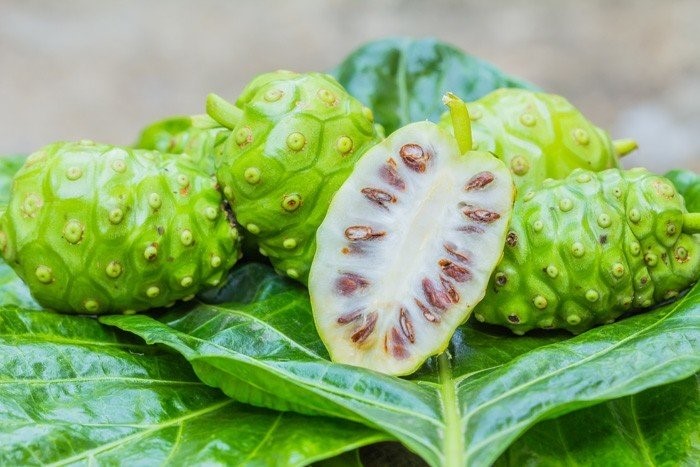What is Noni?
Noni (whose scientific name is Morinda citrifolia) is a shrub of the Rubiaceae family, with interesting medicinal properties. It has several names besides noni, such as guanabana cimarrona, devil fruit or Indian mulberry.
It is a small tree, with large leaves that have well-marked veins, bright green bark, white flowers that appear throughout the year, and yellowish, rough fruits with many seeds. Once mature, they take a strong and unpleasant odor.
It is native to Southeast Asia, and also grows in the tropical regions of India, Polynesia, Mexico, Panama, in a wide variety of environments, whether forests, forests, volcanic terrains, coastal places, and even the courtyards of houses, always in warm conditions, with little care and under shade or sun. The maximum height at which they grow is 300 meters above sea level.
Both fruits, leaves, flowers, stems, barks and roots have medicinal properties: It maintains the health of the heart, relieves the pains of arthritis, accelerates the healing of wounds, and its juice contains vitamins, minerals and many nutrients that provide benefits for the Health
What are its properties?
Noni is made up of several substances, but its properties are related to three important compounds: xeronines, scopoletins and damnacantal. Xeronins are alkaloids, important in the strengthening of body and mind. The scopoletinas are coumarins that regulate blood pressure, eliminate bacteria, are anti-inflammatory and help reduce anxiety and depression by regulating the hormone serotonin. Damnacantal is a quinone, which is extracted from the roots, and has an anticancer effect, since it inhibits the growth of tumor cells in certain types of liver cancer.
It is rich in essential amino acids, such as alanine, arginine, cystine, phenylalanine, glycine, isoleucine, leucine, methionine, proline and tryptophan. They are essential for the proper metabolism of the body, and also have effects on anemia, mobility of muscles, the functioning of hormones, antibodies and enzymes, and infections.
Its antioxidant function is explained thanks to the content of vitamin A and C, eugenol and beta-carotene, which protect the cells from aging and contribute to improving overall health.

noni fruit, seeds and leaves
What are its benefits?
1) Regulates blood pressure and has effects on cholesterol, helping to improve the health of people with hypertension.
2) It is antioxidant. It avoids the wear and aging of the cells, since it helps eliminate toxins and has a high content of vitamins and minerals, which helps to maintain good health in general.
3) It has anticancer properties, due to the presence of damnacantal, which stops the multiplication of cancer cells in certain types of tumors and increases the body’s defenses on them.
4) It helps regulate blood sugar, so it is of interest in diabetes treatments.
5) It is antimicrobial, so it has an effect on certain bacteria that cause intestinal infections or skin, mouth or mucous membranes in general.
6) It contributes to the treatment of psoriasis, since it stimulates the regeneration of the skin both externally and internally.
7) It is a natural relaxant, regulates the mechanisms of the hormone serotonin, improving sleep conditions, and helping the treatment of anxiety and depression.
Traditional and medicinal uses
The fruits look and smell unpleasant, but it is one of the few trees that can be used in its entirety. All its parts have some kind of health benefit.
In tropical areas, its use in medicine is widespread, it is sold in markets at low prices, or some producers sell it in powder form. In Polynesia its use dates back more than 2000 years. It is part of the diet of the natives, raw or cooked, or toasting the seeds. They also extract red, yellow and pink tinctures from the roots to dye clothes. In their medicine traditionally healers used the leaves to treat cough, the roots to lower blood pressure, the bark to cure malaria and the seeds as natural laxatives.
In Malaysia and the Philippines, leaves, fruits, flowers and barks are used as tonics, to treat fever and as respiratory decongestants, and pastes are made to treat arthritis.
Currently, the high demand of the fruit caused that some countries have increased the number of fields that are dedicated to produce noni, to sell the whole fruit, or its juice, either in informal or formal markets, pasteurized, alone or mixed with juices of other fruits such as blackberry or grape. Only Mexico produces more than 200 tons of fruit per year.

noni tree
How is noni consumed?
In some countries you can buy whole fruits, which are consumed raw, liquefied or made juices. Due to its unpleasant taste, it can be drunk in smoothies along with other fruits, such as pineapple, orange or papaya and water. It is recommended to drink it fasting in the morning, or between meals. In addition to doing it at home, pasteurized packaged juices can be purchased.
From the fruits you can make tea, boiling ripened fruits crushed with water, and then straining the pulp and seeds. It must be drunk mixed with other fruits to improve its digestion.
It is also used as a food supplement in the form of noni capsules, which are made from the compressed pulp, from which the water is extracted.



